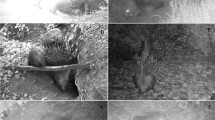Abstract
Reproductive behaviour of free-ranging dogsCanis familiaris Linnaeus, 1758 was studied in a village in the state of West Bengal, India. Increased synchronized breeding was the most striking feature of this study. October (late monsoon) represented the peak period of mating for the feral dogs. Of all courting males, only 41% were observed to mount and copulate. On average, each male mounted 5.47 ± 2.49 (mean ± SD) times per hour. Of all mountings, only 10% were successful matings, ie copulatory ties. There was a negative correlation between the number of courting males and the number of successful copulations. The average duration of copulatory tie was 15.73 ± 7.75 min. Several factors interrupting the duration of copulatory ties were identified. December was the peak period of pup rearing. Mean litter size was 5.70 ± 2.03 with a male-biased sex ratio 1.41:1. Only a single annual breeding cycle recorded here differed from the previous studies on European and American dogs. Mothers spent most of the time with their pups at the dens during the early stage of rearing. The duration of time spent at dens by mothers was minimum when the pups were highly mobile at the age of 10 weeks. The lactating mothers were observed to be more aggressive immediately following litter production. Typically, an old adult male remained near the den as a ‘guard’.
Similar content being viewed by others
References
Adams E. G. P. 1949. Jungle memories: IV. Journal of Bombay Natural History Society 48: 645–655.
Altmann J. 1974. Observational study of behaviour: Sampling method. Behaviour 49: 227–267.
Beach F. A. and Le Boeuf B. J. 1967. Coital behaviour in dogs: 1. Preferential mating in the bitch. Animal Behaviour 15: 546–558.
Beck A. M. 1973. The ecology of stray dogs: a study of free-ranging urban animals. York Press, Baltimore: 1–98.
Bekoff M. 1979. Scent-marking by domestic dogs. Biology of Behaviour 4: 123–139.
Boitani L., Francisci F., Ciucci P. and Andreoli G. 1995. Population biology and ecology of feral dogs in Central Italy. [In: The domestic dog: Its evolution, behaviour and interactions with people. J. Serpell, ed]. Cambridge University Press, New York: 217–244.
Daniels T. J. 1983. The social organization of free-ranging urban dogs. II. Estrous groups and the mating system. Applied Animal Ethology 10: 365–373.
Daniels T. J. and Bekoff M. 1989. Population and social biology of free-ranging dogs,Canis familiaris. Journal of Mammalogy 70: 754–762.
Engle E. T. 1946. No seasonal breeding cycle in dogs. Journal of Mammalogy 27: 79–81.
Ghosh B., Choudhuri D. K. and Pal B. 1984. Some aspects of the sexual behaviour of stray dogs,Canis familiaris. Applied Animal Behaviour Science 13: 113–127.
Gipson P. S. 1972. The taxonomy, reproductive biology, food habits, and range of wild canids (Canidae) in Arkansas. PhD thesis, University of Arkansas, Fayetteville: 1–196.
Johnsingh A. J. T. 1982. Reproductive behaviour of the Dholes,Cuon alpinus (Canidae). Journal of Zoology, London 198: 443–463.
Jones E. and Stevens P. L. 1988. Reproduction in wild canids,Canis familiaris from the eastern highlands of Victoria. Australian Wildlife Research 15: 385–394.
Kleiman D. G. 1968. Reproduction in the canidae. International Zoo Yearbook 8: 1–7.
Kleiman D. G. and Eisenberg J. F. 1973. Comparisons of canid and felid social systems from an evolutionary perspectives. Animal Behaviour 21: 637–659.
Kleiman D. G. and Malcolm J. R. 1981. The evolution male parental investment in mammals. [In: Parental care of mammals. D. J. Gubernik and P. H. Klopfer, eds]. Plenum, New York: 347–387.
Kruuk H. 1972. The spoted hyena: A study of predation and social behaviour. Chicago University Press, Chicago: 1–335.
Laundre J. W. and Keller B. L. 1984. Home range size of coyotes: a critical review. The Journal of Wildlife Management 48: 127–139.
Le Boeuf B. J. 1967. Interindividual associations in dogs. Behaviour 29: 268–295.
Macdonald D. W. and Carr G. M. 1995. Variation in the dog society: Between resource dispersion and social flux. [In: The domestic dog: Its evolution, behaviour and interactions with people. J. Serpell, ed]. Cambridge University Press, New York: 199–216.
Natoli E. and De Vito E. 1991. Agonistic behaviour, dominance rank and copulatory success in a large multi-male feral cat,Felis cautus L. colony in central Rome. Animal Behaviour 42: 227–241.
Nesbitt W. H. 1975. Ecology of a feral dog pack on a wildlife refuge. [In: The wild canids: their systematics, behavioural ecology and evolution. M. W. Fox, ed]. Van Nostrand Reinhold, New York: 391–396.
Oppenheimer E. C. and Oppenheimer J. R. 1975. Certain behavioural features in the pariah dog,Canis familiaris in West Bengal. Applied Animal Ethology 2: 81–92.
Pal S. K. 1999. Some aspects of ecology and behaviour of urban free-ranging dogs (Canis familiaris). PhD thesis, University of Burdwan, Burdwan: 1–125.
Pal S. K. 2001. Population ecology of free-ranging urban dogs in West Bengal, India. Acta Theriologica 46: 69–78.
Pal S. K., Ghosh B. and Roy S. 1998. Agonistic behaviour of free-ranging dogs,Canis familiaris in relation to season, sex and age. Applied Animal Behaviour Science 59: 331–348.
Pal S. K., Ghosh B. and Roy S. 1999. Inter- and inta-sexual behaviour of free-ranging dogs,Canis familiaris. Applied Animal Behaviour Science 62: 267–278.
World Health Organization 1988. Report of WHO consultation on dog ecology studies related to rabies control. WHO: Rabies Research 88: 25.
Author information
Authors and Affiliations
Corresponding author
Additional information
Associate Editor was Bogumiła Jędrzejewska.
Rights and permissions
About this article
Cite this article
Pal, S.K. Reproductive behaviour of free-ranging rural dogs in West Bengal, India. Acta Theriol 48, 271–281 (2003). https://doi.org/10.1007/BF03194167
Received:
Accepted:
Issue Date:
DOI: https://doi.org/10.1007/BF03194167



